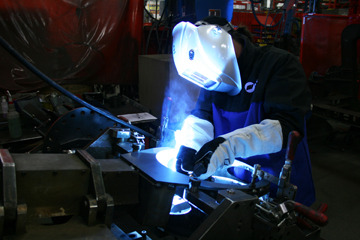Rethinking Metal-Cored Wires
The unique design of metal-cored wires provides numerous advantages to welding operations that are quite “plug-and-play,” requiring only a few minor changes when converting from solid wires. However, reexamining the entire welding process can enhance those advantages.

welding arc. Contact the filler metal manufacturer for help, as
most can offer support after the conversion to metal-cored wires.
To achieve the same amperage as a solid wire, metal-cored wires require higher wire feed speeds, which in turn, increases the deposition rate. The difference between a 1.4 mm-diameter solid wire and metal-cored deposition rate may be approximately 13 percent at 300 amps (10.5 versus 11.9 kilograms per hour, respectively). At 400 amps, the difference is a substantially higher 23 percent (15.6 versus 19.2 kilograms per hour, respectively).
This comparison shows that the best way to get the most out of metal-cored wires is to utilize as high of wire feed speeds (and amperages) as possible. Maximizing deposition rates helps increase travel speeds so that parts can be produced faster.
Although you can short-circuit or use pulsed waveforms for out-of-position metal-cored wire welding, it’s most cost effective to use positioners to keep welds in the flat and horizontal welding position when possible. Automated or mechanized equipment allows consistent, high quality welding at speeds above 380 millimeters per minute — a faster pace than even skilled welders can typically maintain.
By design, metal-cored wires provide excellent productivity, but only if used with the proper equipment kept in good-working condition; it is difficult to be productive when feedability issues lead to frequent down time. To prevent wire deformation, always use V-knurled drive rolls matching the wire size and set to the proper tension. Also, use equipment that provides a sufficient duty-cycle for continuous operation at high-amperage, high-productivity parameters.
Do not assume that because an old process required certain pre or post-weld activities that they will continue to be mandatory when using metal-cored wires. For example, preventing porosity caused by light mill scale and rust may once have required time-consuming cleaning such as grinding and shot blasting. Metal-cored wires tend to have a higher starting content of weld-purifying deoxidizers than most solid wires, making them more tolerant to imperfect surface conditions. This feature eliminates time spent cleaning and leaves more time for welding quality parts.
Getting the most out of any wire requires looking beyond the welding arc. Do not hesitate to contact the filler metal manufacturer for help, as most are dedicated to supporting end users long after the conversion to metal-cored wires.



